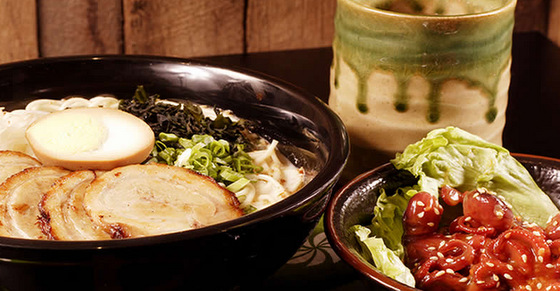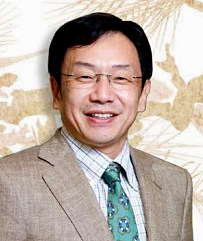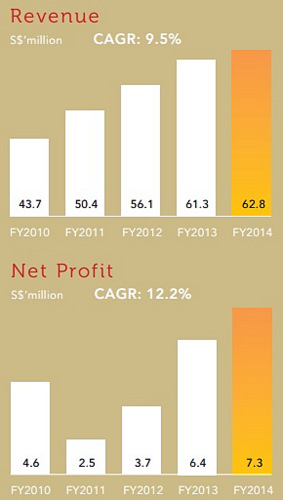RUSMIN ANG is an equity investor and the author of Value Investing in Growth Companies, an international book title published by Wiley, Inc. The book can be found in all major book stores worldwide and on Amazon.com, Amazon.co.uk, Barnes & Noble and Apple's iTunes & iBooks. This article, which is republished with permission, first appeared on FifthPerson.com
 Time & date: 9.30 a.m, 22 July 2014
Time & date: 9.30 a.m, 22 July 2014
Venue: National Library, 100 Victoria Street
|
It’s really simple… be a Japan Foods Holding’s shareholder. |
The 10 Quick Things I Learned From Japan Foods Holding’s AGM 2014:
1. Takahashi Kenichi, CEO and chairman of Japan Foods, has a very good grasp of English though he has a strong Japanese accent and I had difficulties catching some sentences during the Q&A session. Takahashi Kenichi, executive chairman of Japan Foods Holding. Photo: Company2. In 2014, Kenichi was paid remuneration of $716,000 – of which 64% was based on performance. Remuneration agreements like this, which are aligned with the performance of the company, are always highly welcomed by shareholders.
Takahashi Kenichi, executive chairman of Japan Foods Holding. Photo: Company2. In 2014, Kenichi was paid remuneration of $716,000 – of which 64% was based on performance. Remuneration agreements like this, which are aligned with the performance of the company, are always highly welcomed by shareholders.
3. Ajisen Ramen is a cash cow business for Japan Foods contributing 48% of total revenue in 2014. Even though Ajisen is an established brand with a reasonable price point, according to non-executive director Eugene Wong, the maximum number of outlets that Japan Foods can continue to operate profitably in Singapore ranges from 20-25 outlets in the long run. They have 19 so far.
4. The management would never sacrifice bottom-line results for the sake of higher revenues. As such, they are not adopting an aggressive growth strategy in Singapore due to high operating expenses, mainly in rent and labor. Instead, the main strategy of Japan Foods is to continually incubate new concepts in Japan, export them, and expand when proven successful. Japan Foods brands Menya Musashi, which has grown from 9 to 16 outlets in Singapore, Hong Kong and China, and Osaka Ohsho, from 1 to 4 outlets in Singapore, is good example of this strategy. Conservative investors typically like the kind of behavior that Japan Foods' management exhibits: to grow profitably, slowly and steadily.
5. The growth of Ajisen Ramen outlets in the region has slowed in 2014. These regional outlets, located in Indonesia, Malaysia and Vietnam, are operated by sub-franchisees. Therefore, it is entirely up to those operators to expand at a pace that is comfortable with them. If you are shareholder of Japan Foods, do not expect the number of regional outlets to grow significantly. 6. As most of Southeast Asia’s population is predominantly Muslim, it is tough for Japan Foods’ pork-based ramen soup to expand aggressively here. Notwithstanding that, the management is exploring creating other soup bases (chicken) with its original founder, Shigemitsu, so that they can gear up for a higher growth in this region.
6. As most of Southeast Asia’s population is predominantly Muslim, it is tough for Japan Foods’ pork-based ramen soup to expand aggressively here. Notwithstanding that, the management is exploring creating other soup bases (chicken) with its original founder, Shigemitsu, so that they can gear up for a higher growth in this region.
7. Together with Ajisen brand and its two other star brands, Menya Musashi and Osaka Ohsho, Japan Foods is confident of having a total of 60 outlets in Singapore. These brands are mainly targeted at the Chinese population. Besides these three brands, their minor brands are not expected to significantly contribute to revenues in the near future.
8. On risk management, the group’s internal policy is always to reserve cash for at least six months of operating expenses to tide through any storm (SARS, etc.). The Japanese are known to be very conservative and I guess the founder of Japan Foods has shown that famed conservatism here.
9. Japan Foods’ gross margin is extremely high at 81.6% and still improving steadily due to the deployment of an in-house noodle production facility. With this on-going cost control, shareholders can be rest assured that the management is doing something to mitigate rising operating expenses.
10. Japan Foods management invested half-a-million dollars in government-linked bonds (NTUC, DBS, etc.) that will yield at least 3% returns p.a. till maturity. Unlike other F&B companies who pledge their fixed deposits as rental deposits to the mall, Japan Foods uses its bond investments as collateral instead and earns the difference in interest rates. So if money placed in a fixed deposit pays 0.5% interest and Japan Foods’ bond investments pay 3%, the company makes a net gain of 2.5%. A very smart move!
Recent story: @ BreadTalk’s AGM: 12 Quick Things I Learned








I like this company is because the boss fixed salary portion is not high, it is around 20k per month which is much lower than most other listed food company. With earning per shares of 6 cents at present price of 61 it is a PE of 10 only, as compare to other food company in Singapore which range from 30-40 PE like Neo group and Breadtop.
Company has managed cost quite well in the past, with the JV in China for other brand, the group should enjoy constant income flow by doing nothing.
Cheer for those have invested for the past few years.